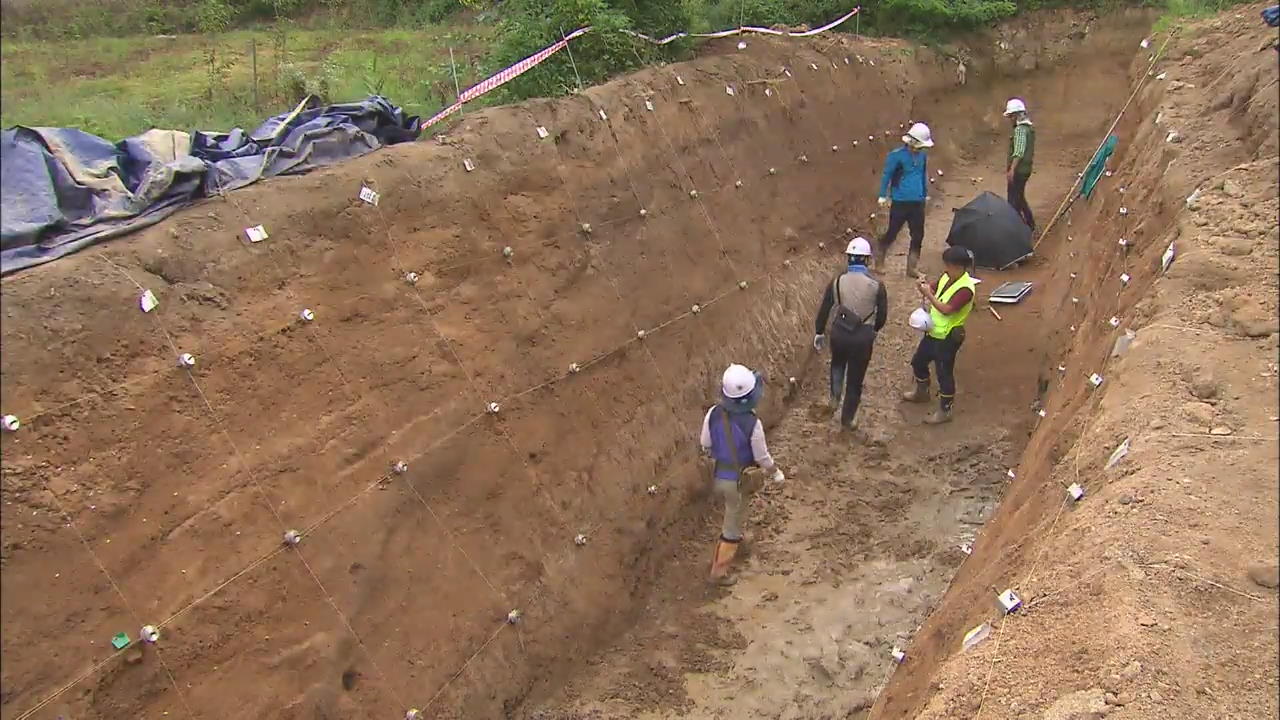Pohang Earthquake
입력 2018.02.13 (15:28)
수정 2018.02.13 (16:45)
읽어주기 기능은 크롬기반의
브라우저에서만 사용하실 수 있습니다.
[Anchor Lead]
It’s the common scientific view that accumulated earthquake energy is released through aftershocks. However, the latest aftershock in Pohang, North Gyeongsang-do Province, is said to have actually increased the chances of another earthquake, as it appeared to be different from previous aftershocks.
[Pkg]
The aftershock of magnitude 4.6 occurred 4.6 kilometers southwest from the epicenter of the main earthquake that shot through Pohang, Gyeongsangbuk-do Province, in last November. It was recorded at the tip of the southwestern area, compared to previous aftershocks. Usually, aftershocks occur along the fault plane that is ripped during the main quake. However, the fact that the largest aftershock occurred at the edge indicates that more fault planes have cracked and expanded.
[Soundbite] Prof. Hong Tae-Gyeong(Yonsei University) : "A newly expanded fault plane suggests the possibility that more aftershocks or another mid- or large-sized earthquake can occur, depending on the length of the fault."
It also overlaps with the region where stress was most built up and powerful during the quakes in Gyeongju and Pohang. When a massive earthquake occurs, stress increases in the direction vertical to the torn fault plane. However, analysts say that the red-marked region between Pohang and Gyeongju demonstrates that the stress building up was doubled by the two tremors.
[Soundbite] Prof. Hong Tae-Gyeong(Yonsei University) : "Stress additionally increased south-westwards during the 4.6-magnitude aftershock. It is necessary to closely examine the region since it overlaps with the area where stress increased in the past."
Experts say that close examinations on fault planes are urgent in order to exactly identify the risks and magnitudes of potential earthquakes.
It’s the common scientific view that accumulated earthquake energy is released through aftershocks. However, the latest aftershock in Pohang, North Gyeongsang-do Province, is said to have actually increased the chances of another earthquake, as it appeared to be different from previous aftershocks.
[Pkg]
The aftershock of magnitude 4.6 occurred 4.6 kilometers southwest from the epicenter of the main earthquake that shot through Pohang, Gyeongsangbuk-do Province, in last November. It was recorded at the tip of the southwestern area, compared to previous aftershocks. Usually, aftershocks occur along the fault plane that is ripped during the main quake. However, the fact that the largest aftershock occurred at the edge indicates that more fault planes have cracked and expanded.
[Soundbite] Prof. Hong Tae-Gyeong(Yonsei University) : "A newly expanded fault plane suggests the possibility that more aftershocks or another mid- or large-sized earthquake can occur, depending on the length of the fault."
It also overlaps with the region where stress was most built up and powerful during the quakes in Gyeongju and Pohang. When a massive earthquake occurs, stress increases in the direction vertical to the torn fault plane. However, analysts say that the red-marked region between Pohang and Gyeongju demonstrates that the stress building up was doubled by the two tremors.
[Soundbite] Prof. Hong Tae-Gyeong(Yonsei University) : "Stress additionally increased south-westwards during the 4.6-magnitude aftershock. It is necessary to closely examine the region since it overlaps with the area where stress increased in the past."
Experts say that close examinations on fault planes are urgent in order to exactly identify the risks and magnitudes of potential earthquakes.
■ 제보하기
▷ 카카오톡 : 'KBS제보' 검색, 채널 추가
▷ 전화 : 02-781-1234, 4444
▷ 이메일 : kbs1234@kbs.co.kr
▷ 유튜브, 네이버, 카카오에서도 KBS뉴스를 구독해주세요!
- Pohang Earthquake
-
- 입력 2018-02-13 15:23:21
- 수정2018-02-13 16:45:27

[Anchor Lead]
It’s the common scientific view that accumulated earthquake energy is released through aftershocks. However, the latest aftershock in Pohang, North Gyeongsang-do Province, is said to have actually increased the chances of another earthquake, as it appeared to be different from previous aftershocks.
[Pkg]
The aftershock of magnitude 4.6 occurred 4.6 kilometers southwest from the epicenter of the main earthquake that shot through Pohang, Gyeongsangbuk-do Province, in last November. It was recorded at the tip of the southwestern area, compared to previous aftershocks. Usually, aftershocks occur along the fault plane that is ripped during the main quake. However, the fact that the largest aftershock occurred at the edge indicates that more fault planes have cracked and expanded.
[Soundbite] Prof. Hong Tae-Gyeong(Yonsei University) : "A newly expanded fault plane suggests the possibility that more aftershocks or another mid- or large-sized earthquake can occur, depending on the length of the fault."
It also overlaps with the region where stress was most built up and powerful during the quakes in Gyeongju and Pohang. When a massive earthquake occurs, stress increases in the direction vertical to the torn fault plane. However, analysts say that the red-marked region between Pohang and Gyeongju demonstrates that the stress building up was doubled by the two tremors.
[Soundbite] Prof. Hong Tae-Gyeong(Yonsei University) : "Stress additionally increased south-westwards during the 4.6-magnitude aftershock. It is necessary to closely examine the region since it overlaps with the area where stress increased in the past."
Experts say that close examinations on fault planes are urgent in order to exactly identify the risks and magnitudes of potential earthquakes.
It’s the common scientific view that accumulated earthquake energy is released through aftershocks. However, the latest aftershock in Pohang, North Gyeongsang-do Province, is said to have actually increased the chances of another earthquake, as it appeared to be different from previous aftershocks.
[Pkg]
The aftershock of magnitude 4.6 occurred 4.6 kilometers southwest from the epicenter of the main earthquake that shot through Pohang, Gyeongsangbuk-do Province, in last November. It was recorded at the tip of the southwestern area, compared to previous aftershocks. Usually, aftershocks occur along the fault plane that is ripped during the main quake. However, the fact that the largest aftershock occurred at the edge indicates that more fault planes have cracked and expanded.
[Soundbite] Prof. Hong Tae-Gyeong(Yonsei University) : "A newly expanded fault plane suggests the possibility that more aftershocks or another mid- or large-sized earthquake can occur, depending on the length of the fault."
It also overlaps with the region where stress was most built up and powerful during the quakes in Gyeongju and Pohang. When a massive earthquake occurs, stress increases in the direction vertical to the torn fault plane. However, analysts say that the red-marked region between Pohang and Gyeongju demonstrates that the stress building up was doubled by the two tremors.
[Soundbite] Prof. Hong Tae-Gyeong(Yonsei University) : "Stress additionally increased south-westwards during the 4.6-magnitude aftershock. It is necessary to closely examine the region since it overlaps with the area where stress increased in the past."
Experts say that close examinations on fault planes are urgent in order to exactly identify the risks and magnitudes of potential earthquakes.
이 기사가 좋으셨다면
-
좋아요
0
-
응원해요
0
-
후속 원해요
0

















이 기사에 대한 의견을 남겨주세요.